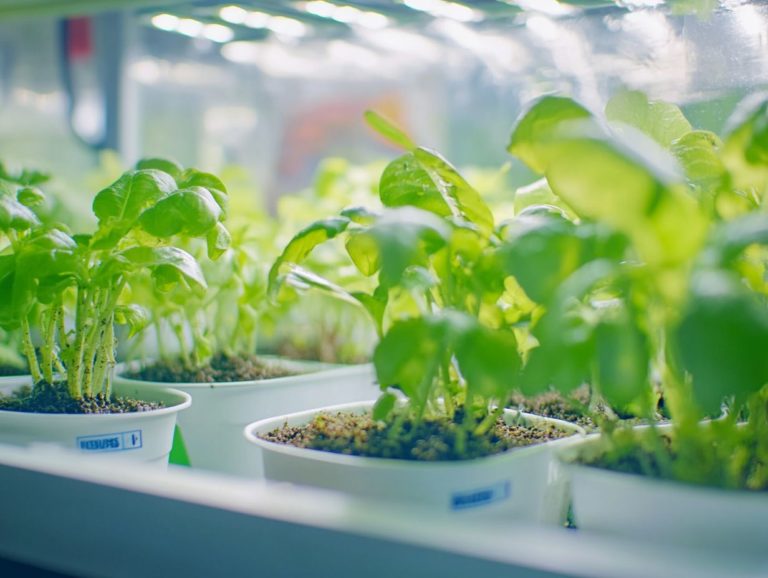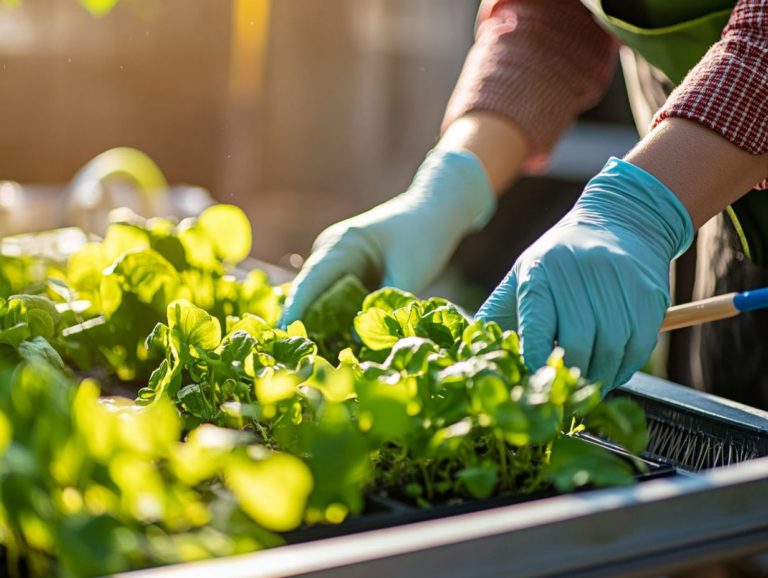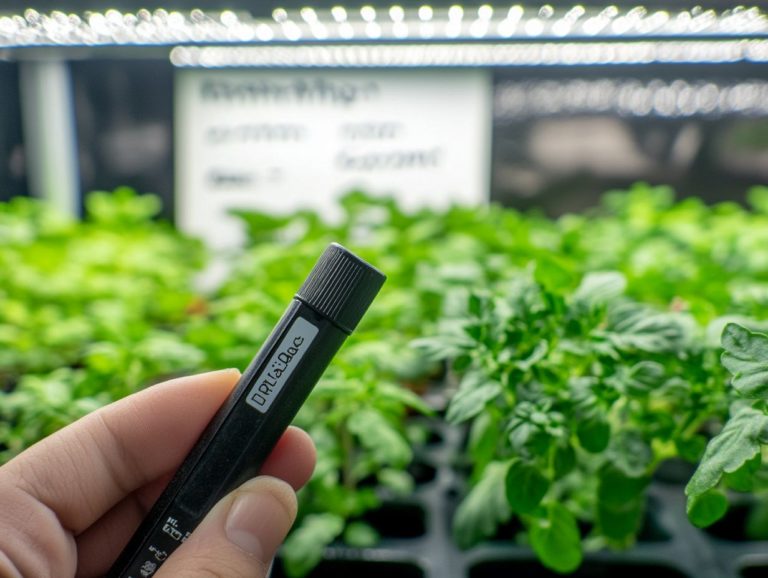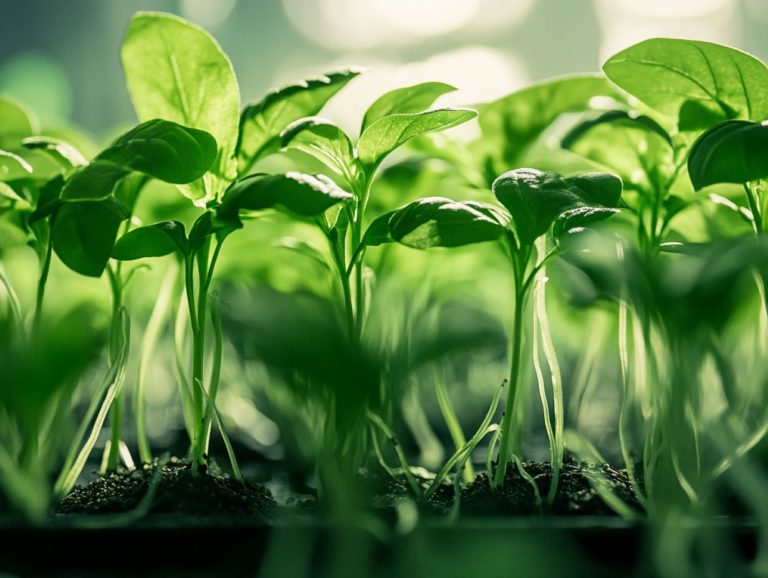5 Essential Hydroponic Maintenance Checks
Maintaining a hydroponic system is essential for ensuring that your plants thrive and your harvests are plentiful.
This article highlights five vital maintenance checks that every hydroponic gardener should prioritize:
- Checking and adjusting pH levels
- Monitoring nutrient levels and environmental conditions
- Inspecting and cleaning equipment
- Maintaining proper lighting
- Controlling pests and diseases
Get ready to uncover why these maintenance tasks are game-changers for your garden! You ll also discover the common issues that can arise from neglect and practical tips to streamline your maintenance routine.
Immerse yourself in this knowledge to keep your hydroponic setup in peak condition!
Contents
- Key Takeaways:
- 1. Checking and Adjusting pH Levels
- 2. Monitoring Nutrient Levels
- 3. Inspecting and Cleaning Equipment
- 4. Maintaining Proper Lighting
- 5. Controlling Pests and Diseases
- Why Is Proper Maintenance Important for Hydroponic Systems?
- Frequently Asked Questions
- Discover the 5 Essential Hydroponic Maintenance Checks!
- Why is it Important to Regularly Check the pH Level in a Hydroponic System?
- How Often Should I Check the Nutrient Levels in My Hydroponic System?
- Can I Use Tap Water in My Hydroponic System?
- Why is Checking the Lighting Important in Hydroponic Maintenance?
- What Are the Signs That Equipment Maintenance is Needed in a Hydroponic System?
Key Takeaways:
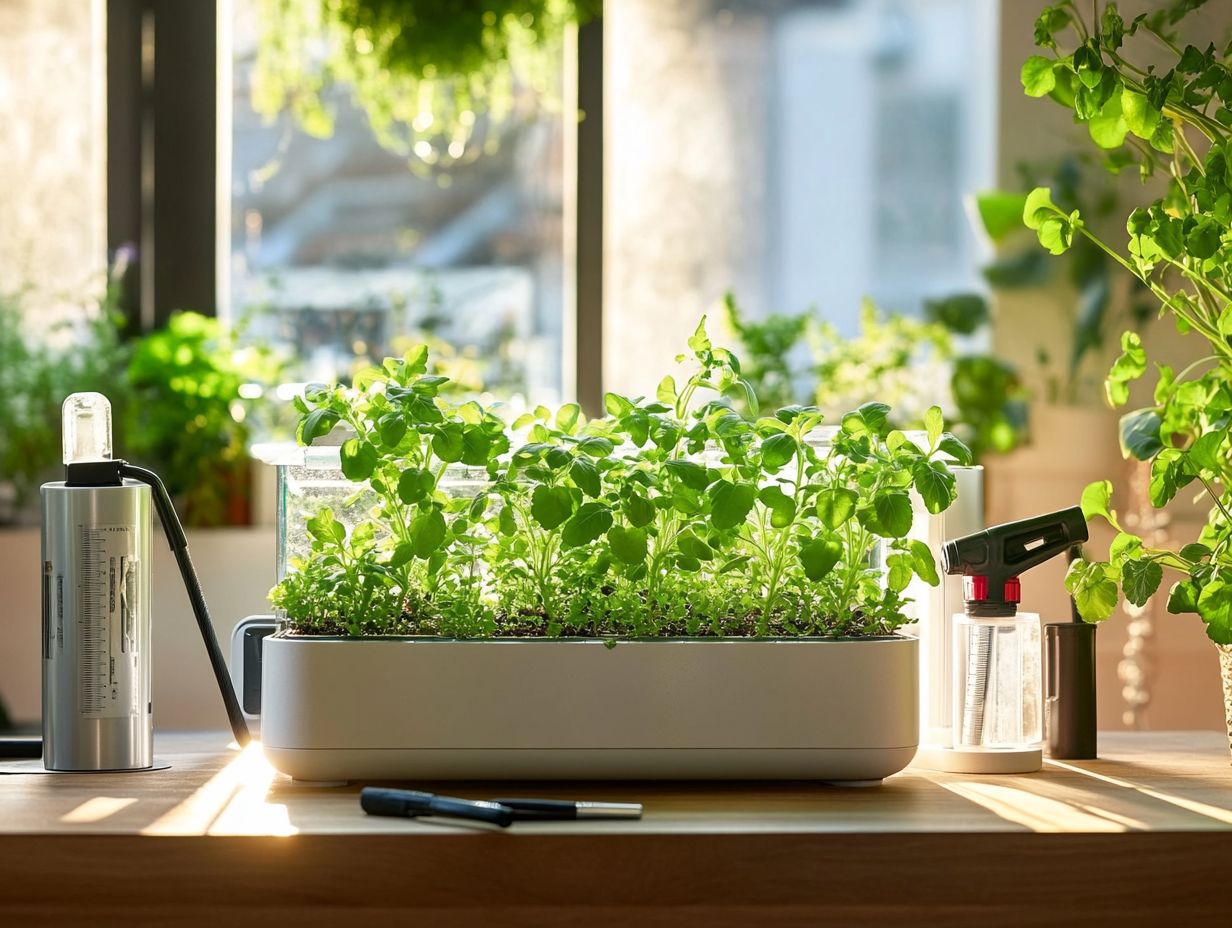
- Keep your pH levels in check to fuel vibrant growth.
- Regular monitoring of nutrient levels is crucial for the health and productivity of hydroponic plants.
- Equipment should be regularly inspected and cleaned to prevent buildup of debris and bacteria.
1. Checking and Adjusting pH Levels
Maintaining the proper pH levels is essential for the success of your hydroponic system. It directly influences the availability of nutrients to your plants and their overall health.
It also affects the activity of beneficial microbes that promote growth. As hydroponic gardening continues to gain popularity, understanding how to check and adjust your pH levels is crucial. Additionally, incorporating 5 must-know nutrient tips for hydroponics ensures your plants thrive in optimal conditions, maximizing their growth potential and preventing nutrient deficiencies or toxicities.
Regular monitoring of pH is critical, as even small fluctuations can significantly affect plant health and yield. Using tools like TDS meters and pH kits can greatly assist you in accurately assessing these levels.
A TDS meter measures total dissolved solids, giving you insight into the overall nutrient concentration, while pH kits test the acidity or alkalinity of your solution. Most plants in hydroponic systems flourish within a pH range of 5.5 to 6.5, though certain varieties may require minor adjustments.
When imbalances arise, keep an eye out for signs like yellowing leaves or stunted growth, which may indicate that nutrients are locked out.
To correct pH levels, common household solutions can come to your rescue. For instance, vinegar can help lower pH, while baking soda can elevate it. Regular maintenance and checks are crucial for sustaining a balanced environment, ultimately fostering lush, vibrant growth.
2. Monitoring Nutrient Levels
To achieve maximum growth and optimal plant health in your hydroponic setup, monitoring nutrient levels frequently is essential. This ensures that your nutrient solution has the perfect balance of essential minerals and elements.
Using tools like TDS meters, which measure nutrient levels, is very helpful. These meters provide precise readings that help you make necessary adjustments.
By understanding the specific growth stages of the plants you re cultivating, you can create effective feeding schedules tailored to their needs. For instance, during the vegetative stage, a higher nitrogen concentration might be necessary, while the flowering stage could demand increased potassium levels.
It’s also vital to remain adaptable. By closely observing how your plants respond to nutrient concentrations, you’ll be able to make prompt adjustments, ensuring that optimal conditions are maintained throughout their growth cycle.
3. Inspecting and Cleaning Equipment
Regularly inspecting and cleaning your equipment is essential for maintaining a successful hydroponic system. It ensures that all components function optimally and prevents the buildup of algae or harmful pathogens in your pristine reservoir.
To achieve effective maintenance, arm yourself with essential cleaning tools like brushes, sponges, and scrapers. These will make it easy to remove any buildup from surfaces.
When you inspect system components, pay close attention to water pumps for any signs of wear or blockage, and check air circulation systems to confirm they re operating efficiently.
Regularly examining your grow lights for dirt and functionality can significantly enhance plant growth. Implementing effective pest management strategies such as utilizing beneficial insects or organic pesticides is vital for protecting plant health and preventing infestations that could jeopardize your entire system. Additionally, staying informed about understanding hydroponic system maintenance can further ensure a thriving garden.
4. Maintaining Proper Lighting

Maintaining proper lighting is essential for your hydroponic garden. It directly influences light distribution and creates the best environment for growth.
Choosing the right lighting system is fundamental. Options like LED and HID lights each offer unique benefits tailored to different growth stages. LED lights are not only energy-efficient but also emit a spectrum perfectly suited for photosynthesis. In contrast, HID lights deliver powerful intensity but require careful management of heat and energy consumption.
As your plants transition from seedlings to flowering stages, adjusting both light intensity and duration becomes crucial. For example, seedlings typically thrive with 16-18 hours of light daily, while flowering plants often need a shift to 12 hours.
Selecting a reliable power source, such as a dependable outlet or a generator, ensures that your lighting setup remains consistent and effective. This consistency is vital for maintaining the health and yield of your plants.
5. Controlling Pests and Diseases
Effective pest management is crucial for protecting your hydroponic produce. Pests and diseases can easily disturb the delicate balance of your growing environment and jeopardize plant health.
Common culprits like aphids, spider mites, and powdery mildew thrive in hydroponic settings. They can lead to diminished yields and weakened plants. To tackle these challenges effectively, consider utilizing beneficial microbes. For instance, beneficial fungi such as mycorrhizae help plants absorb nutrients, while Trichoderma can outcompete harmful pathogens.
Incorporating organic pesticides into your strategy provides a safe way to manage pest populations without leaving harmful residues. However, beyond just treatment, implementing preventive measures is essential. Regular cleaning and monitoring of environmental variables like humidity and temperature can go a long way.
By maintaining a clean and optimal environment, you can significantly decrease the likelihood of infestations and ensure the robust growth of your hydroponic crops.
Why Is Proper Maintenance Important for Hydroponic Systems?
Proper maintenance of your hydroponic systems is essential for ensuring plant health, maximizing growth potential, and maintaining optimal environments.
Stay ahead by monitoring your system regularly! This includes checking nutrient solutions, pH levels, and equipment functionality.
By taking a proactive approach to hydroponic gardening, you can prevent issues such as nutrient imbalances, disease outbreaks, and equipment failures. These issues could significantly impact your plant yields and overall productivity.
Committing to regular maintenance practices allows you to create an ecosystem that promotes healthy growth and bountiful harvests, elevating your hydroponic setup to new heights.
Investing your time in these tasks not only enhances the immediate health of your plants but also leads to long-term savings and improved system efficiency.
For instance, keeping your water systems clean ensures that nutrients are absorbed more readily. This reduces waste and minimizes the need for costly replacements or chemical inputs.
Neglecting maintenance can lead to serious problems like clogged systems or mold growth. Both can decrease yields and increase your financial outlay. Ultimately, a well-maintained hydroponic environment supports thriving plants and fosters a more sustainable and cost-effective approach to modern agriculture.
Maintaining a Hydroponic System is Crucial
What Are the Common Problems That Can Arise If Maintenance Is Neglected?
Neglecting regular maintenance in your hydroponic system can lead to serious issues, such as nutrient imbalances, diminished plant health, and the unwelcome spread of diseases and algae. To avoid these problems and enhance your setup, consider following 5 tips for efficient hydroponic gardening. These strategies can help maintain overall productivity.
When nutrient absorption falters, your plants may struggle to thrive. This makes them more vulnerable to pest infestations and stress-related challenges. Without proper attention, nutrient-rich water can quickly become a breeding ground for algae, which not only siphons off essential resources but also blocks vital sunlight, disrupting photosynthesis. This domino effect can jeopardize both yield and quality.
To sidestep these complications, you must regularly monitor nutrient levels, pH balances, and the physical cleanliness of your system. Establish routine monitoring schedules and incorporate beneficial microorganisms to enhance your plants’ resilience and the overall health of your hydroponic setup. Additionally, consider using 5 essential tools for hydroponic gardening to streamline the process.
How Often Should These Maintenance Checks Be Done?

For optimal plant health and to ensure your hydroponic system operates efficiently, conduct regular maintenance checks with specific tasks scheduled daily, weekly, and monthly.
This structured approach sustains healthy plant growth and maximizes your yield over time. Each day, focus on closely monitoring nutrient levels and pH, as even slight fluctuations can significantly impact plant development. To enhance your setup, consider checking out these 5 upgrades for your existing hydroponic system.
Weekly equipment inspections are crucial; they help identify any signs of wear or malfunction, ensuring everything runs smoothly. Don’t overlook the importance of a thorough deep cleaning every month this vital step removes buildup and prevents pests or diseases from taking hold.
By consistently adhering to these schedules, you can effectively mitigate risks and address potential issues before they escalate into bigger problems.
What Are the Tools and Supplies Needed for Hydroponic Maintenance?
To maintain your hydroponic system effectively, you’ll need a variety of essential tools and supplies. Cleaning tools are crucial for keeping your equipment in top shape, while testing kits help monitor nutrient levels and pH. You’ll also want components that keep your nutrient reservoir pristine.
Some of the most important tools include pH meters, which ensure the acidity or alkalinity of your nutrient solution is optimal, and TDS meters, which measure total dissolved solids. Don’t forget about cleaning brushes or algae scrubbers; they’re key for preventing blockages and keeping surfaces clear. Additionally, knowing how to troubleshoot hydroponic system failures can also enhance your gardening success.
You can find these vital instruments at gardening supply stores or online retailers that specialize in hydroponics. Each tool serves a significant purpose; for example, regular testing with a pH meter helps maintain nutrient absorption efficiency, while diligent cleaning wards off algae growth that could compromise your system’s health. Additionally, learning how to maintain hydroponic equipment is crucial for optimal performance.
With the right tools, you enhance your yield and foster a more sustainable and productive growing environment.
Are There Any Tips for Streamlining the Maintenance Process?
Streamlining the maintenance process for your hydroponic system can significantly enhance efficiency and ensure regular tasks are completed without being overwhelming.
To achieve this, craft a structured maintenance schedule that outlines your daily, weekly, and monthly responsibilities. Utilize checklists to simplify this process, allowing you to focus on specific duties like checking nutrient levels, cleaning reservoirs, and monitoring plant health. For detailed guidance, refer to this resource on how to maintain your hydroponic growing system. Establishing a consistent routine makes maintenance easier and aids in tracking your system’s overall performance.
Incorporate pest management strategies such as employing natural predators or using organic treatments into your routine to prevent infestations, reducing unexpected workloads. Optimize environmental conditions like humidity, temperature, and light to create a better atmosphere for plant growth, leading to less frequent maintenance requirements.
How Can One Troubleshoot and Fix Common Maintenance Issues?
Troubleshooting common maintenance issues in your hydroponic system requires a methodical approach. Focus on identifying the root causes of problems, whether they arise from a lack of essential nutrients, equipment failures, or pest infestations.
Begin by assessing each component. This ensures your plants receive the optimal care they need. Start with a check on nutrient levels; an imbalance here can significantly stunt growth. Next, inspect your equipment for malfunctions. For more detailed guidance, refer to this resource on how to troubleshoot common hydroponic issues. Ensuring pumps and lights function correctly is crucial.
Don’t overlook environmental conditions! Temperature and humidity play vital roles in your plants’ health. A step-by-step guide empowers you to tackle key issues effectively. Timely interventions, like adjusting pH levels, are essential for keeping your plants healthy.
Frequently Asked Questions
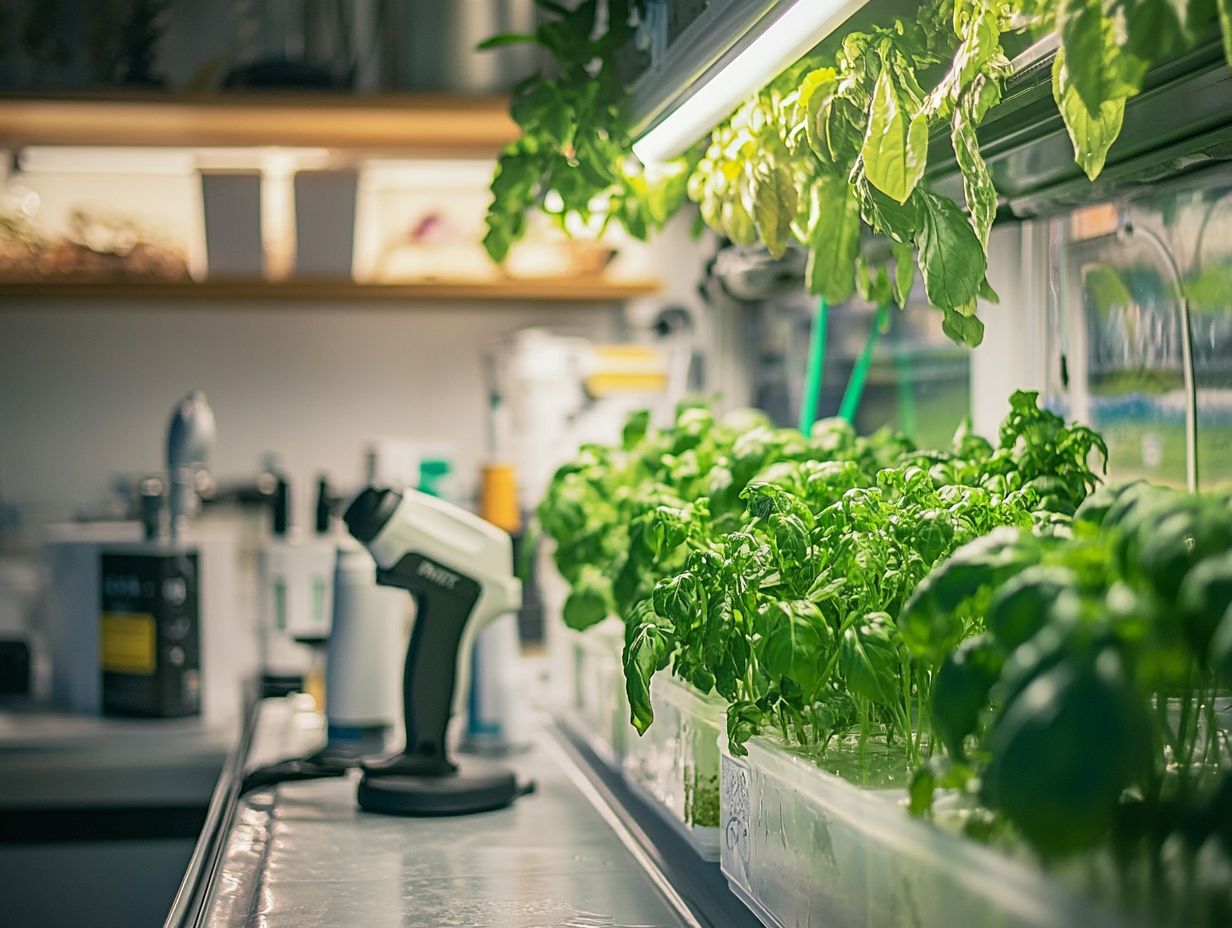
Discover the 5 Essential Hydroponic Maintenance Checks!
- pH level
- Nutrient levels
- Water levels
- Lighting
- Equipment functionality
Why is it Important to Regularly Check the pH Level in a Hydroponic System?
The pH level, which measures acidity or alkalinity, affects nutrient absorption by plants. Regular monitoring and adjustment ensure optimal nutrient uptake and plant growth.
How Often Should I Check the Nutrient Levels in My Hydroponic System?
Nutrient levels should be checked at least once a week. Plants can quickly deplete nutrients in a closed hydroponic system. Adjustments may need to be made more frequently, depending on plant growth and water usage.
Can I Use Tap Water in My Hydroponic System?
It is not recommended to use tap water in a hydroponic system. It may contain high levels of minerals and chemicals that can harm plants. Use filtered or distilled water for optimal plant growth.
Why is Checking the Lighting Important in Hydroponic Maintenance?
Lighting is crucial for plant growth in a hydroponic system. Regularly checking ensures that plants receive the right amount and type of light for their specific needs.
What Are the Signs That Equipment Maintenance is Needed in a Hydroponic System?
If plants are not growing as expected, there may be an issue with the equipment. Signs such as leaks, clogs, or malfunctioning pumps should be addressed immediately to ensure the health of the plants.

